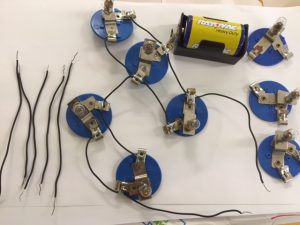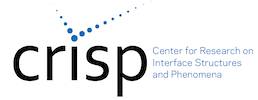Our kits are currently being reviewed and updated by a team of collaborative, innovative and interdisciplinary educators who wish to enhance the educational opportunities for students. These dedicated teachers are members of CRISP Collaborative Science for All (CCSA) as well as local educators.
Click to see the SCSU CRISP Module Template used by CCSA for improving and updating the CRISP demos and kits. Each kit page offers a CRISP developed teacher module and CRISP aligned standards (both NGSS and CCSS)
Kit Request form

Developed by CRISP – adapted from SCSU Physics 100 circuit labs
Subject(s):
Technology and Society, Electricity, Circuits
Objectives:
- Students will be able to identify and differentiate between insulators and conductors, as well as understand how electricity flows in a circuit.
- Students will develop experimental models and use the scientific method in order to determine if their data is based on scientific observation versus assumption
Materials in this kit:
- 2 D Batteries
- 2 Battery holders
- 5 Bulb holders
- 5 Mini light bulbs
- ~3ft black wire
Suggestions for the Teacher:
- Make sure you have enough supplies for each student so they can each conduct their own experimentation.
- Demonstrating how to set up each experiment may help the lab run more smoothly, so practice setting up each model prior to the lab.
- This is a three-part lab and very detail oriented, so be sure to check the students’ process throughout the experimentation.
- Batteries will drain quickly so have students disconnect the circuit when not in use
Safety:
Additional Resources:
DC Circuits teacher module
DC Circuits CRISP aligned standards
Circuits lab 2
Circuits lab 3
Circuits lab 1
STEM Careers:
Electrical Engineer
Materials Scientist
Researcher
Electrician
Engineer
Computer hardware Engineer
Electrical Engineering Technologists
Electrical and Electronic Engineering Technicians
Electro-Mechanical Technicians
Nanosystems Engineers
Standards:
HS – PS3-4.
- Apply scientific ideas to design, test, and refine a device that converts energy from one form to another.
PS3.B: Conservation of Energy and Energy Transfer
- Energy can also be transferred from place to place by electric currents, which can then be used locally to produce motion, sound, heat, or light.
PS3.A: Definitions of Energy
- “Electrical energy” may mean energy stored in a battery or energy transmitted by electric currents.
- Energy can be moved from place to place by moving objects or through sound, light, or electric currents.
CCC 3 - Cause and Effect
- Empirical evidence is required to differentiate between cause and correlation and make claims about specific causes and effects.
CCC 5 - Energy and Matter
- Energy can be transferred in various ways and between objects.
SEP 4 - Planning and Carrying out Investigations
- Plan and conduct an investigation individually and collaboratively to produce data to serve as the basis for evidence, and in the design: decide on types, how much, and accuracy of data needed to produce reliable measurements and consider limitations on the precision of the data (e.g., number of trials, cost, risk, time), and refine the design accordingly.
